engine MAZDA MODEL CX-9 2009 (in English) Workshop Manual
[x] Cancel search | Manufacturer: MAZDA, Model Year: 2009, Model line: MODEL CX-9, Model: MAZDA MODEL CX-9 2009Pages: 538, PDF Size: 12.18 MB
Page 181 of 538

Black plate (181,1)
During deceleration, the gears shift down
automatically when speed is reduced to
the following:
Gear Vehicle speed
M6→M5 47 km/h (29 mph)
M5→M4 37 km/h (22 mph)
M4→M3 26 km/h (16 mph)
M3 or M2→M1 9 km/h (5 mph)
NOTE
The gear does not shift down to M1
automatically while in the second gear fixed
mode.
If the vehicle is kicked down at the
following speeds or lower, the gears shift
down automatically:
Gear Vehicle speed
M6→M5 230 km/h (142 mph)
M5→M4 90 km/h (55 mph)
M4→M3 65 km/h (40 mph)
M3→M2 40 km/h (24 mph)
Recommendations for shifting
Upshifting
For normal acceleration and cruising, we
recommend these shift points.
Gear Vehicle speed
M1 to M2 24 km/h (15 mph)
M2 to M3 40 km/h (25 mph)
M3 to M4 65 km/h (40 mph)
M4 to M5 73 km/h (45 mph)
M5 to M6 80 km/h (50 mph)
Downshifting
When you must slow down in heavy
traffic or on a steepupgrade, downshift
before the engine starts to overwork. This
gives better acceleration when you need
more speed.On a steepdowngrade, downshifting
helps maintain safe speed and prolongs
brake life.
qDriving Tips
Passing
For extra power when passing another
vehicle or climbing steep grades, depress
the accelerator fully. The transaxle will
shift to a lower gear, depending on vehicle
speed.
Climbing steep grades from a stop
To climb a steep grade from a stopped
position:
1. Depress the brake pedal.
2. Shift to D or M1, depending on the
load weight and grade steepness.
3. Release the brake pedal while
gradually accelerating.
Descending steep grades
When descending a steep grade, shift to
lower gears, depending on load weight
and grade steepness. Descend slowly,
using the brakes only occasionally to
prevent them from overheating.
Driving Your Mazda
Starting and Driving
5-15
CX-9_8Z66-EA-08F_Edition3 Page181
Tuesday, March 31 2009 1:52 PM
Form No.8Z66-EA-08F
Page 182 of 538

Black plate (182,1)
Power Steering
Power steering is only operable when the
engine is running. If the engine is off or if
the power steering system is inoperable,
you can still steer, but it requires more
physical effort.
If the steering feels stiffer than usual
during normal driving, consult an
Authorized Mazda Dealer.
CAUTION
Never hold the steering wheel to the
extreme left or right for more than 5
seconds with the engine running.
This could damage the power
steering system.
All-Wheel Drive (AWD)
Operation
í
AWD provides excellent driveability on
snow-covered and ice-packed roads, sand
and mud, as well as on steep slopes and
other slippery surfaces.
5-16
Driving Your Mazda
íSome models.
Starting and Driving
CX-9_8Z66-EA-08F_Edition3 Page182
Tuesday, March 31 2009 1:52 PM
Form No.8Z66-EA-08F
Page 188 of 538
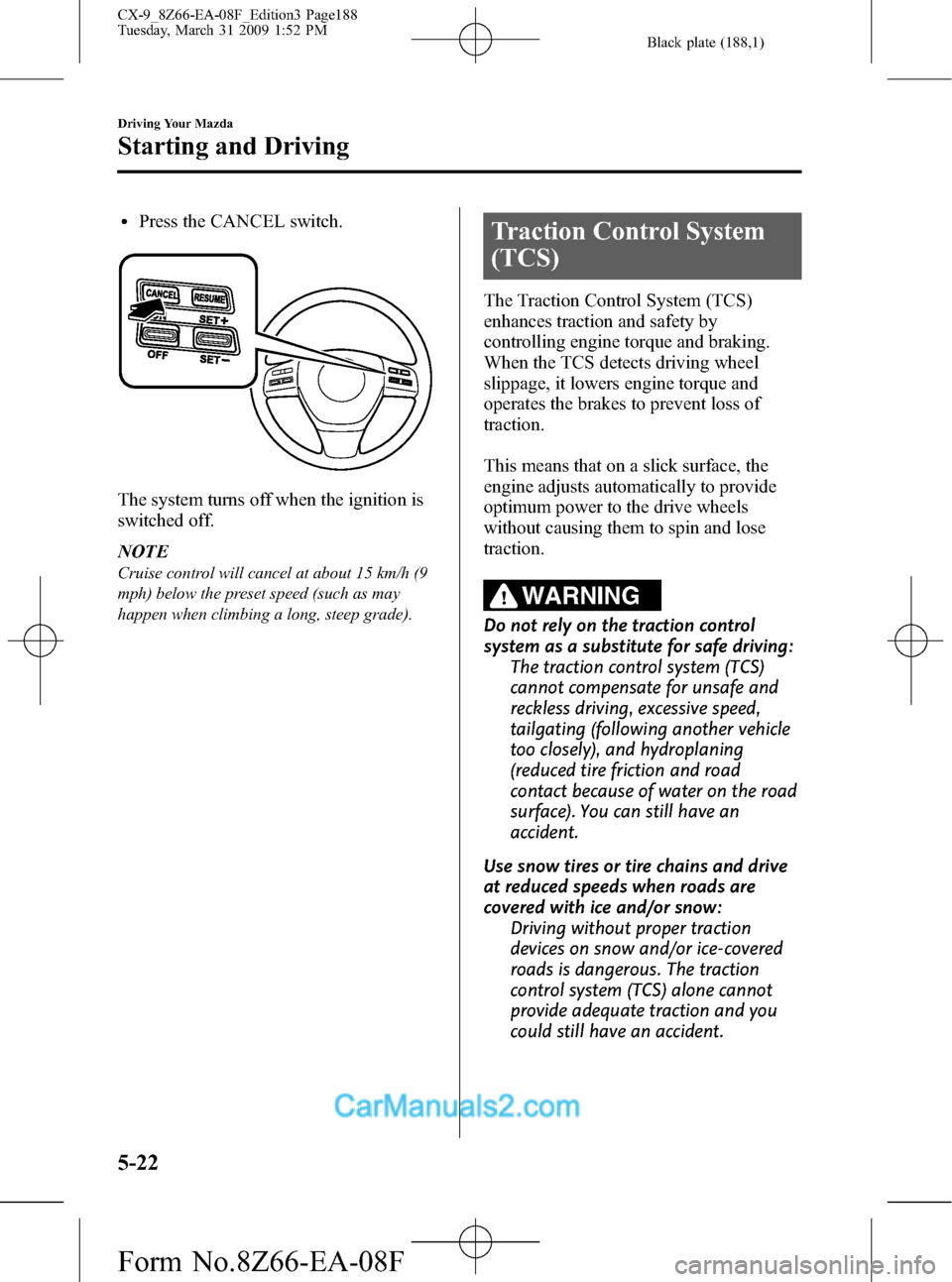
Black plate (188,1)
lPress the CANCEL switch.
The system turns off when the ignition is
switched off.
NOTE
Cruise control will cancel at about 15 km/h (9
mph) below the preset speed (such as may
happen when climbing a long, steep grade).
Traction Control System
(TCS)
The Traction Control System (TCS)
enhances traction and safety by
controlling engine torque and braking.
When the TCS detects driving wheel
slippage, it lowers engine torque and
operates the brakes to prevent loss of
traction.
This means that on a slick surface, the
engine adjusts automatically to provide
optimum power to the drive wheels
without causing them to spin and lose
traction.
WARNING
Do not rely on the traction control
system as a substitute for safe driving:
The traction control system (TCS)
cannot compensate for unsafe and
reckless driving, excessive speed,
tailgating (following another vehicle
too closely), and hydroplaning
(reduced tire friction and road
contact because of water on the road
surface). You can still have an
accident.
Use snow tires or tire chains and drive
at reduced speeds when roads are
covered with ice and/or snow:
Driving without proper traction
devices on snow and/or ice-covered
roads is dangerous. The traction
control system (TCS) alone cannot
provide adequate traction and you
could still have an accident.
5-22
Driving Your Mazda
Starting and Driving
CX-9_8Z66-EA-08F_Edition3 Page188
Tuesday, March 31 2009 1:52 PM
Form No.8Z66-EA-08F
Page 189 of 538

Black plate (189,1)
CAUTION
Do not rely on the TCS to maintain
constant control of the vehicle under
severe or maximum handling
conditions. If the TCS operates
frequently due to severe driving
conditions, the TCS may stop
operating to protect the brakes from
overheating. After the brakes have
cooled down, the TCS resumes
normal operation.
qTCS/DSC Indicator Light
This indicator light stays on for a few
seconds when the ignition switch is turned
to the ON position. If the TCS or DSC is
operating, the indicator light flashes.
If the light stays on, the TCS, DSC or the
brake assist system may have a
malfunction and they may not operate
correctly. Take your vehicle to an
Authorized Mazda Dealer.
NOTE
lIn addition to the indicator light flashing, a
slight lugging sound will come from the
engine. This indicates that the TCS is
operating properly.
lOn slippery surfaces, such as fresh snow, it
will be impossible to achieve high rpm
when the TCS is on.
qTCS OFF Indicator Light
This indicator light stays on for a few
seconds when the ignition switch is turned
to the ON position.
It also illuminates when the TCS OFF
switch is pressed and TCS is switched off.
Refer to TCS OFF Switch on page 5-24.
If the light remains illuminated and the
TCS is not switched off, take your vehicle
to an Authorized Mazda Dealer. The
dynamic stability control may have a
malfunction.
NOTE
If the TCS/DSC indicator light and the TCS
OFF indicator light remain illuminated even
after turning the ignition switch to the ON
position, attempt the procedure again. If this
still does not work, consult an Authorized
Mazda Dealer.
Driving Your Mazda
Starting and Driving
5-23
CX-9_8Z66-EA-08F_Edition3 Page189
Tuesday, March 31 2009 1:52 PM
Form No.8Z66-EA-08F
Page 190 of 538

Black plate (190,1)
qTCS OFF Switch
If the vehicle speed is less than 15 km/h
(9 mph), press the TCS OFF switch to
turn off the TCS. The TCS OFF indicator
light will illuminate.
Press the switch again to turn the TCS
back on. The TCS OFF indicator light
will turn off. If the vehicle speed is more
than 15 km/h (9 mph), the TCS OFF
indicator light will not illuminate even if
the switch is pressed.NOTE
lWhen TCS is on and you attempt to free the
vehicle when it is stuck, or drive it out of
freshly fallen snow, the TCS will activate.
Depressing the accelerator will not
increase engine power and freeing the
vehicle may be difficult. When this happens,
turn off the TCS.
lIf the TCS is off when the engine is turned
off, it automatically activates when the
ignition switch is turned on.
lLeaving the TCS on will provide the best
traction.
lIf the TCS is OFF when the vehicle speed is
more than 15 km/h (9 mph), it
automatically activates and the TCS OFF
indicator light will turn off.
lIf the TCS OFF switch is pressed and held
for 10 seconds or more, the TCS OFF
switch malfunction detection function
operates and the TCS and DSC/RSC system
activates automatically. The TCS OFF
indicator light turns off while the TCS
system is operative.
5-24
Driving Your Mazda
Starting and Driving
CX-9_8Z66-EA-08F_Edition3 Page190
Tuesday, March 31 2009 1:52 PM
Form No.8Z66-EA-08F
Page 191 of 538
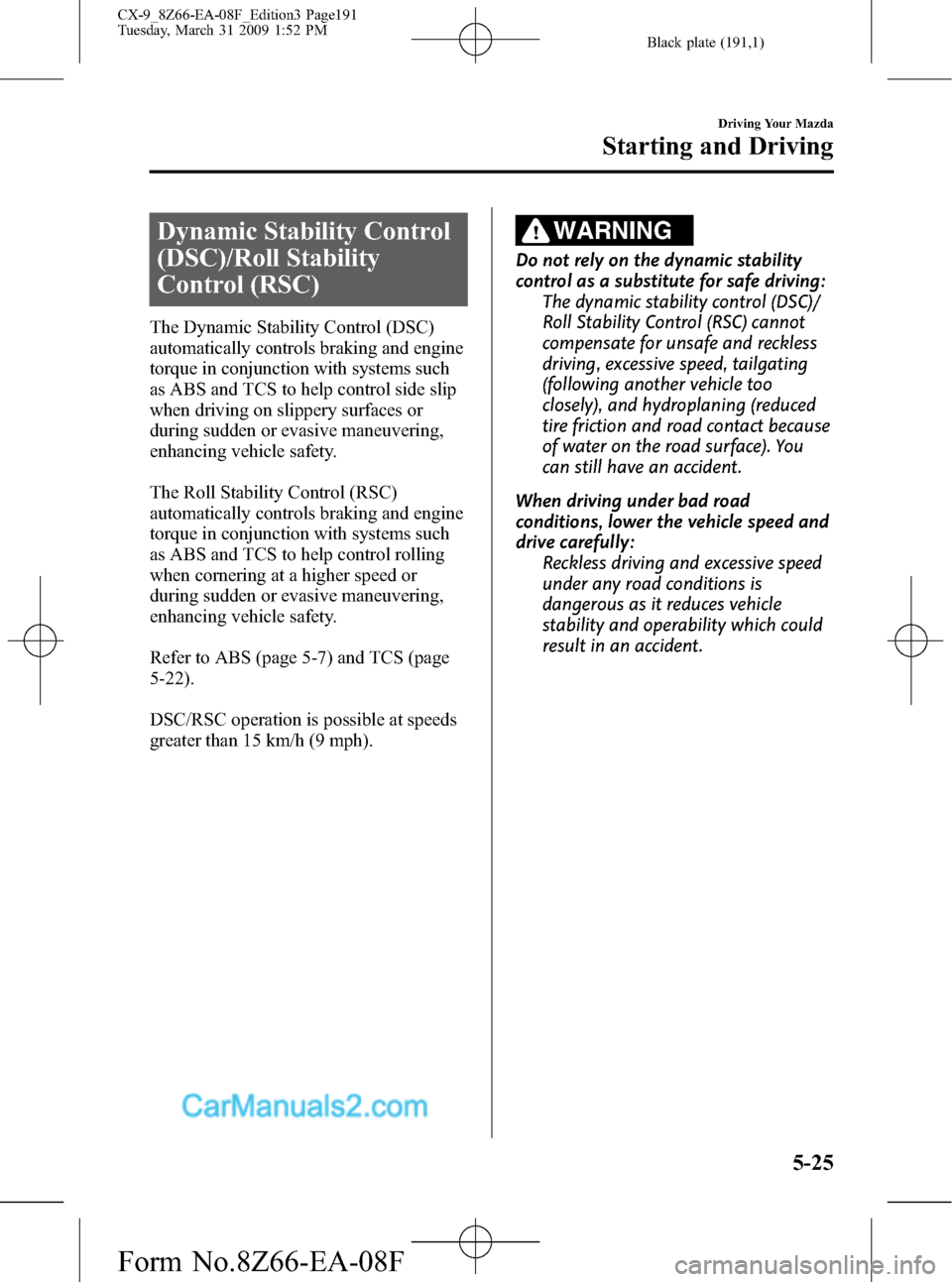
Black plate (191,1)
Dynamic Stability Control
(DSC)/Roll Stability
Control (RSC)
The Dynamic Stability Control (DSC)
automatically controls braking and engine
torque in conjunction with systems such
as ABS and TCS to help control side slip
when driving on slippery surfaces or
during sudden or evasive maneuvering,
enhancing vehicle safety.
The Roll Stability Control (RSC)
automatically controls braking and engine
torque in conjunction with systems such
as ABS and TCS to help control rolling
when cornering at a higher speed or
during sudden or evasive maneuvering,
enhancing vehicle safety.
Refer to ABS (page 5-7) and TCS (page
5-22).
DSC/RSC operation is possible at speeds
greater than 15 km/h (9 mph).
WARNING
Do not rely on the dynamic stability
control as a substitute for safe driving:
The dynamic stability control (DSC)/
Roll Stability Control (RSC) cannot
compensate for unsafe and reckless
driving, excessive speed, tailgating
(following another vehicle too
closely), and hydroplaning (reduced
tire friction and road contact because
of water on the road surface). You
can still have an accident.
When driving under bad road
conditions, lower the vehicle speed and
drive carefully:
Reckless driving and excessive speed
under any road conditions is
dangerous as it reduces vehicle
stability and operability which could
result in an accident.
Driving Your Mazda
Starting and Driving
5-25
CX-9_8Z66-EA-08F_Edition3 Page191
Tuesday, March 31 2009 1:52 PM
Form No.8Z66-EA-08F
Page 204 of 538
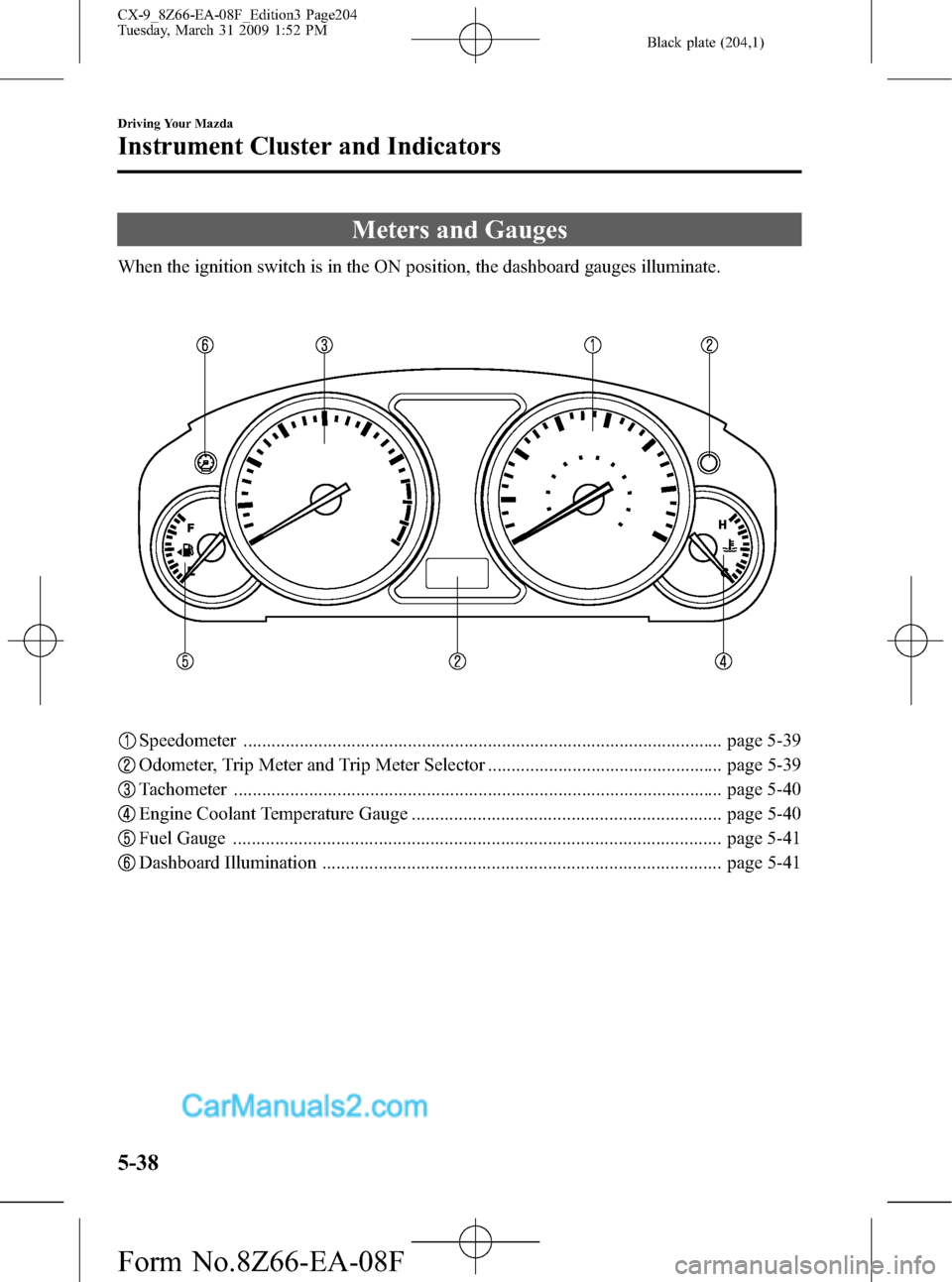
Black plate (204,1)
Meters and Gauges
When the ignition switch is in the ON position, the dashboard gauges illuminate.
Speedometer ...................................................................................................... page 5-39
Odometer, Trip Meter and Trip Meter Selector .................................................. page 5-39
Tachometer ........................................................................................................ page 5-40
Engine Coolant Temperature Gauge .................................................................. page 5-40
Fuel Gauge ........................................................................................................ page 5-41
Dashboard Illumination ..................................................................................... page 5-41
5-38
Driving Your Mazda
Instrument Cluster and Indicators
CX-9_8Z66-EA-08F_Edition3 Page204
Tuesday, March 31 2009 1:52 PM
Form No.8Z66-EA-08F
Page 206 of 538
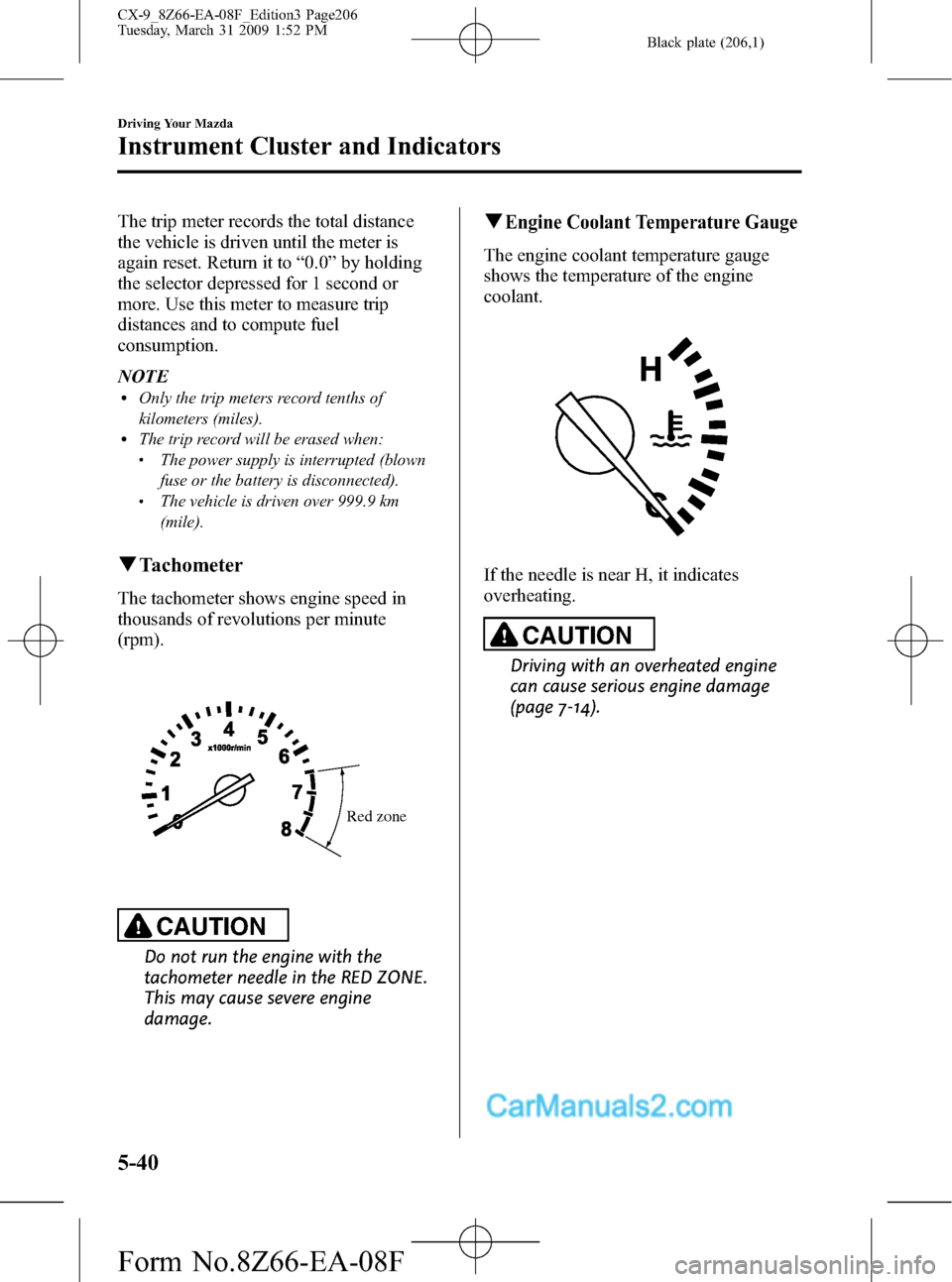
Black plate (206,1)
The trip meter records the total distance
the vehicle is driven until the meter is
again reset. Return it to“0.0”by holding
the selector depressed for 1 second or
more. Use this meter to measure trip
distances and to compute fuel
consumption.
NOTE
lOnly the trip meters record tenths of
kilometers (miles).
lThe trip record will be erased when:lThe power supply is interrupted (blown
fuse or the battery is disconnected).
lThe vehicle is driven over 999.9 km
(mile).
qTachometer
The tachometer shows engine speed in
thousands of revolutions per minute
(rpm).
Red zone
CAUTION
Do not run the engine with the
tachometer needle in the RED ZONE.
This may cause severe engine
damage.
qEngine Coolant Temperature Gauge
The engine coolant temperature gauge
shows the temperature of the engine
coolant.
If the needle is near H, it indicates
overheating.
CAUTION
Driving with an overheated engine
can cause serious engine damage
(page 7-14).
5-40
Driving Your Mazda
Instrument Cluster and Indicators
CX-9_8Z66-EA-08F_Edition3 Page206
Tuesday, March 31 2009 1:52 PM
Form No.8Z66-EA-08F
Page 209 of 538
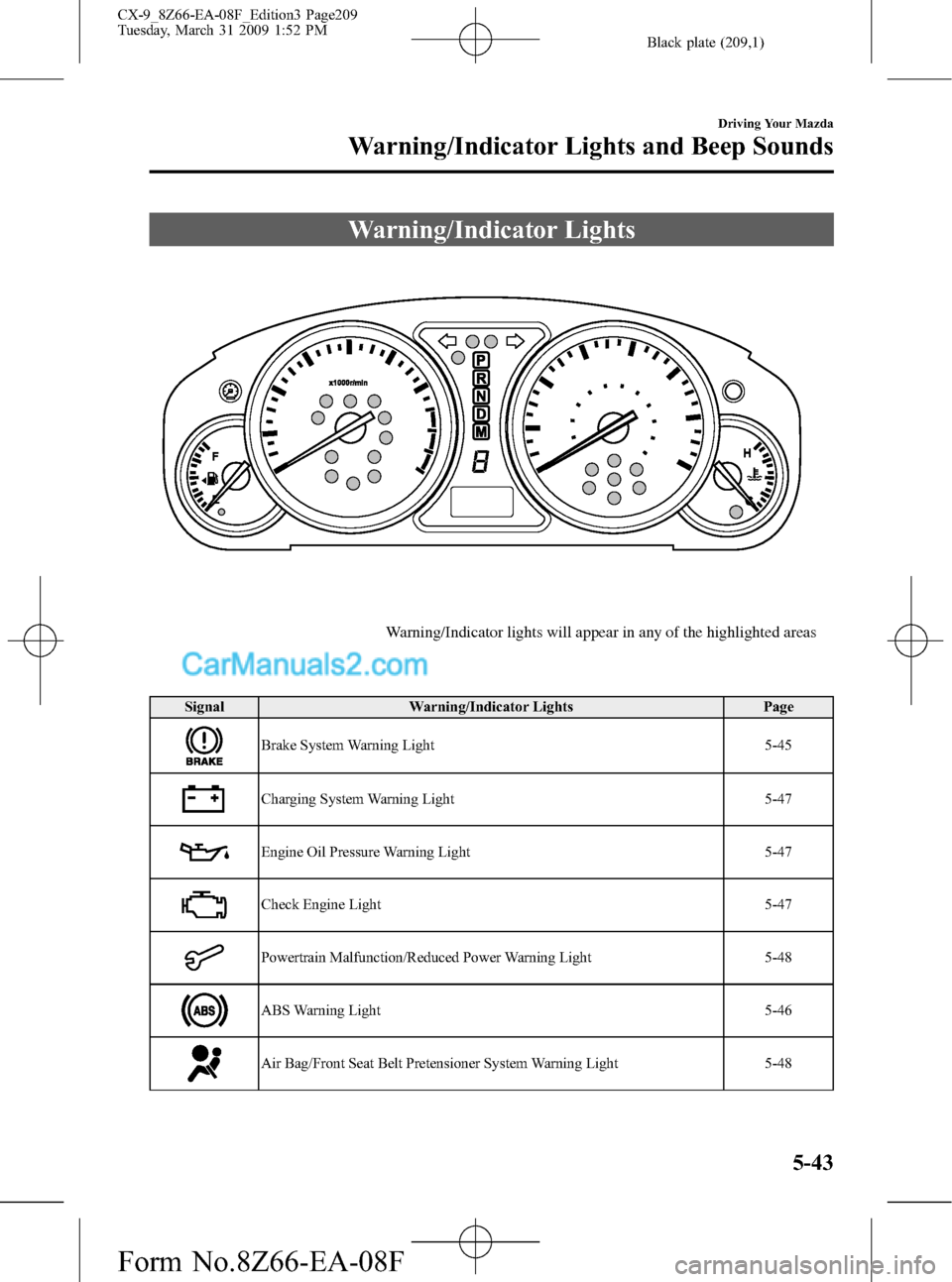
Black plate (209,1)
Warning/Indicator Lights
Warning/Indicator lights will appear in any of the highlighted areas
Signal Warning/Indicator Lights Page
Brake System Warning Light 5-45
Charging System Warning Light 5-47
Engine Oil Pressure Warning Light 5-47
Check Engine Light 5-47
Powertrain Malfunction/Reduced Power Warning Light 5-48
ABS Warning Light 5-46
Air Bag/Front Seat Belt Pretensioner System Warning Light 5-48
Driving Your Mazda
Warning/Indicator Lights and Beep Sounds
5-43
CX-9_8Z66-EA-08F_Edition3 Page209
Tuesday, March 31 2009 1:52 PM
Form No.8Z66-EA-08F
Page 211 of 538

Black plate (211,1)
Signal Warning/Indicator Lights Page
Lights-On Indicator Light 5-58
Turn Signal/Hazard Warning Indicator Lights 5-58
qBrake System Warning Light
This warning has the following functions:
Parking brake warning
The light illuminates when the parking
brake is applied with the ignition switch
in the START or ON position. It turns off
when the parking brake is fully released.
Low brake fluid level warning
If the light stays on after the parking brake
is fully released, you may have a brake
problem.
Drive to the side of the road and park off
the right-of-way.
You may notice that the pedal is harder to
depress or that it may go closer to the
floor. In either case, it will take longer to
stop the vehicle.
1. With the engine stopped, open the
hood and check the brake fluid level
immediately, and then add fluid if
required (page 8-23).
2. After adding fluid, check the light
again.If the warning light remains on, or if the
brakes do not operate properly, do not
drive the vehicle. Have it towed to an
Authorized Mazda Dealer.
Even if the light turns off have your brake
system inspected as soon as possible by
an Authorized Mazda Dealer.
NOTE
Having to add brake fluid is sometimes an
indicator of leakage. Consult an Authorized
Mazda Dealer as soon as possible even if the
brake light is no longer illuminated.
WARNING
Do not drive with the brake system
warning light illuminated. Contact an
Authorized Mazda Dealer to have the
brakes inspected as soon as possible:
Driving with the brake system
warning light illuminated is
dangerous. It indicates that your
brakes may not work at all or that
they could completely fail at any
time. If this light remains
illuminated, after checking that the
parking brake is fully released, have
the brakes inspected immediately.
Driving Your Mazda
Warning/Indicator Lights and Beep Sounds
5-45
CX-9_8Z66-EA-08F_Edition3 Page211
Tuesday, March 31 2009 1:52 PM
Form No.8Z66-EA-08F